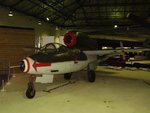The He-162A-2 Salamander whilst being an excellent design and one of the best fighters of the war, is often over-looked incorrectly referred to as flimsy and hard to fly. The He-162 is infact an engineering marvel of its time, with excellent aerodynamic properties weight distribution. The problems plaguing the final A-2 production model were engine unreliability, scarce supply of the right materials forcing use of substitute ones which in turn caused defects, and bombing of production facilities. The Allied bombing of factories forced a few production lines to move underground, and it was from there the few excellent condition He-162's delivered came from.

From an aerodynamic engineering point of view the He-162 is an 100% excellent sound design with a very good layout. The low weight, high performance engine and small size of the a/c coupled with the perfectly sized wings and aerodynamically clean design meant a very high top speed, climb rate, excellent turn rate and roll rate. The good layout also meant it was a delight to fly, being very agile in all aspects of flight and featuring good control responsiveness. The only thing to take care of was applying too much rudder, as the aircraft was unusually responsive here and applying to much rudder at high speed could cause a structural failure of the tail.
All of the above coupled with a few new advanced features (Ejection seat) made the He-162A-2 a truly excellent fighter aircraft and one of the best designs to see service during the war.
Eric Brown called the He-162 a first class fighter aircraft, and often flew it for fun after the war.

After the war a good number of He-162's were restored and used as solo trainers for Jet fighter pilots, a role in which it served beautifully.
He-162 A-2 specifications:
Length: 9.05 m
Wing span: 7.2 m
Wing area: 14.5 m^2
Weight empty: 1,660 kg
Weight fully loaded: 2,800 kg
Climb rate: 23.4 m/s (4,615 ft/min)
Service ceiling: 12 km (39,400 ft)
Take Off Roll: 500m (Very short for an early jet fighter!)
Range: 975 km (606 miles)
Armament: 2 x 20mm MG151/20 cannons

From an aerodynamic engineering point of view the He-162 is an 100% excellent sound design with a very good layout. The low weight, high performance engine and small size of the a/c coupled with the perfectly sized wings and aerodynamically clean design meant a very high top speed, climb rate, excellent turn rate and roll rate. The good layout also meant it was a delight to fly, being very agile in all aspects of flight and featuring good control responsiveness. The only thing to take care of was applying too much rudder, as the aircraft was unusually responsive here and applying to much rudder at high speed could cause a structural failure of the tail.
All of the above coupled with a few new advanced features (Ejection seat) made the He-162A-2 a truly excellent fighter aircraft and one of the best designs to see service during the war.
Eric Brown called the He-162 a first class fighter aircraft, and often flew it for fun after the war.
After the war a good number of He-162's were restored and used as solo trainers for Jet fighter pilots, a role in which it served beautifully.
He-162 A-2 specifications:
Length: 9.05 m
Wing span: 7.2 m
Wing area: 14.5 m^2
Weight empty: 1,660 kg
Weight fully loaded: 2,800 kg
Climb rate: 23.4 m/s (4,615 ft/min)
Service ceiling: 12 km (39,400 ft)
Take Off Roll: 500m (Very short for an early jet fighter!)
Range: 975 km (606 miles)
Armament: 2 x 20mm MG151/20 cannons


